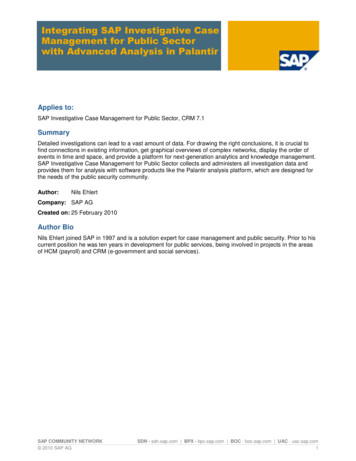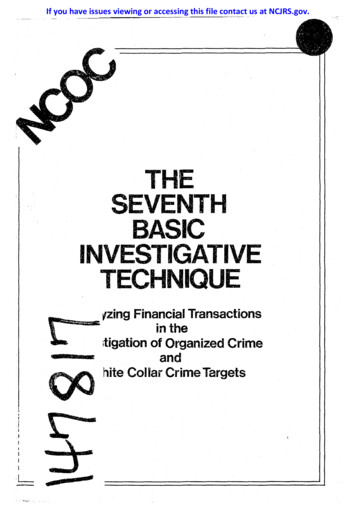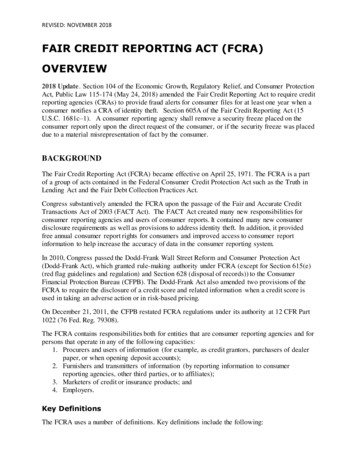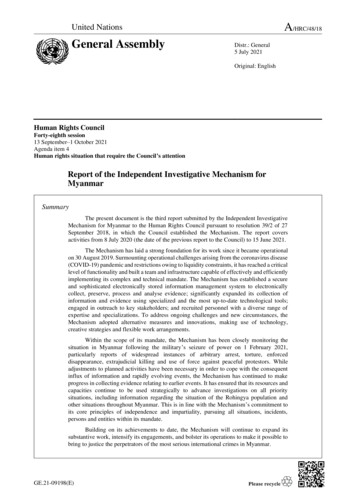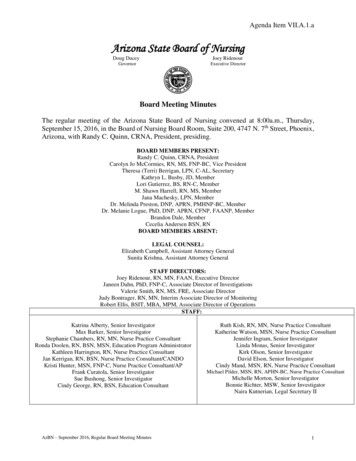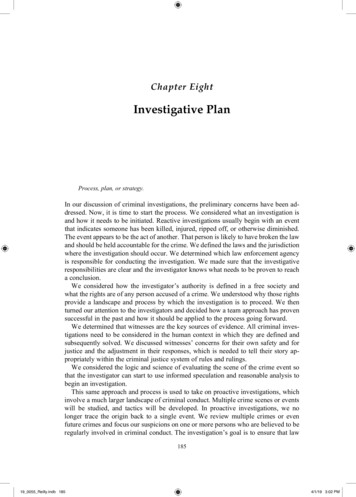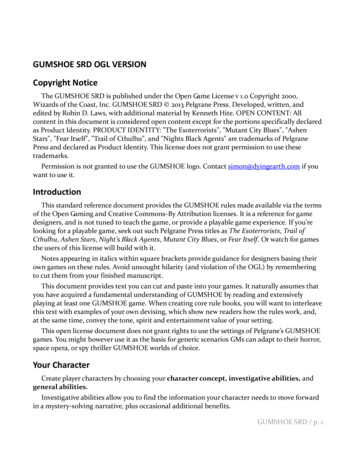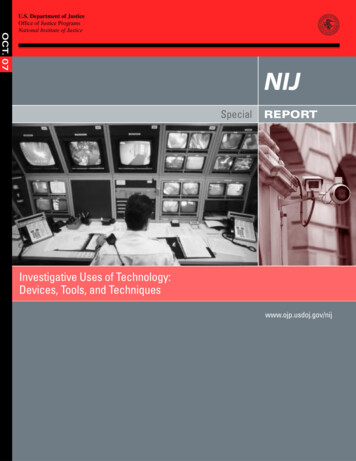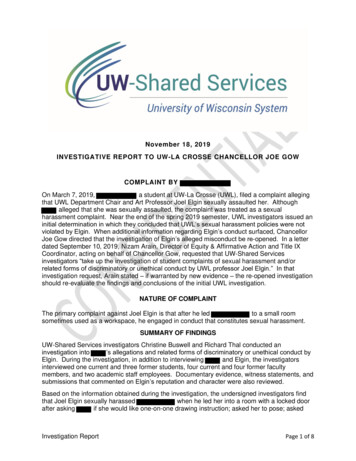
Transcription
November 18, 2019INVESTIGATIVE REPORT TO UW-LA CROSSE CHANCELLOR JOE GOWCOMPLAINT BYOn March 7, 2019,a student at UW-La Crosse (UWL), filed a complaint allegingthat UWL Department Chair and Art Professor Joel Elgin sexually assaulted her. Althoughalleged that she was sexually assaulted, the complaint was treated as a sexualharassment complaint. Near the end of the spring 2019 semester, UWL investigators issued aninitial determination in which they concluded that UWL’s sexual harassment policies were notviolated by Elgin. When additional information regarding Elgin’s conduct surfaced, ChancellorJoe Gow directed that the investigation of Elgin’s alleged misconduct be re-opened. In a letterdated September 10, 2019, Nizam Arain, Director of Equity & Affirmative Action and Title IXCoordinator, acting on behalf of Chancellor Gow, requested that UW-Shared Servicesinvestigators “take up the investigation of student complaints of sexual harassment and/orrelated forms of discriminatory or unethical conduct by UWL professor Joel Elgin.” In thatinvestigation request, Arain stated – if warranted by new evidence – the re-opened investigationshould re-evaluate the findings and conclusions of the initial UWL investigation.NATURE OF COMPLAINTThe primary complaint against Joel Elgin is that after he ledto a small roomsometimes used as a workspace, he engaged in conduct that constitutes sexual harassment.SUMMARY OF FINDINGSUW-Shared Services investigators Christine Buswell and Richard Thal conducted aninvestigation into’s allegations and related forms of discriminatory or unethical conduct byElgin. During the investigation, in addition to interviewingand Elgin, the investigatorsinterviewed one current and three former students, four current and four former facultymembers, and two academic staff employees. Documentary evidence, witness statements, andsubmissions that commented on Elgin’s reputation and character were also reviewed.Based on the information obtained during the investigation, the undersigned investigators findthat Joel Elgin sexually harassedwhen he led her into a room with a locked doorafter askingif she would like one-on-one drawing instruction; asked her to pose; askedInvestigation ReportPage 1 of 8
her to take her sweater off; commented on her body with words of exclamation; and twice beganto lift her tank top.Elgin’s conduct was sexual harassment because: Elgin touchedand started to lift her shirt.The physical conduct followed verbal conduct of a sexual nature, and the physicalconduct also constituted conduct of a sexual nature.Elgin’s conduct had the effect of substantially interfering with’s academicperformance, and it created an intimidating, hostile, and offensive educationalenvironment.BACKGROUNDenrolled at UW-La Crosse in the fall of 2014. During the spring semester of herfreshman year, who then planned to major in art, took the following two art classes: Art160 – Gen Art Foundation and Art 318 – Printmaking Lithography. Joel Elgin taught Art 318.Althoughhad not taken the prerequisite drawing class for enrollment in Art 318, therequirement was waived. Elgin and some other faculty in the Department of Art oftenrecommended the waiver of prerequisites. From the fall of 2015 through the fall of 2019, Elginrecommended such waivers for 314 students. The waivers were recommended for both femaleand male students.SCOPE OF THE INVESTIGATIONThe investigation focused on whetherwas the victim of sexual harassment or sexualassault. Under UW-La Crosse’s Policy Against Discrimination, Discriminatory Harassment,Sexual Misconduct and Retaliation and Regent Policy RPD 14-2, Sexual Violence and SexualHarassment, UWL is committed to providing an educational environment that is free ofdiscriminatory harassment and sexual misconduct.Section 4.3 of UWL’s Policy Against Discrimination, Discriminatory Harassment, SexualMisconduct and Retaliation includes a definition of sexual harassment, adapted from thedefinition contained in RPD 14-2. Under that definition:Sexual harassment includes unwelcome sexual advances, requests for sexual favors,and other physical conduct and expressive behavior of a sexual nature where:.(c) such conduct has the purpose or effect of substantially interfering with anindividual’s academic or professional performance or creating an intimidating,hostile or offensive employment or educational environment.The different degrees of sexual assault are set forth in Wis. Stat. § 940.225 and in RPD 14-2.Fourth degree sexual assault is defined as “Sexual contact with a person without the consent ofthat person.” The definition of sexual contact contained in RPD 14-2, in relevant part, (which isadapted from the Wis. Stat. § 940.225(5)(b)1 definition) is as follows:intentional touching, whether direct or through clothing, if that intentional touching is forthe purpose of sexually degrading or sexually humiliating the complainant or sexuallyarousing or gratifying the defendant . . . . .Investigation ReportPage 2 of 8
INVESTIGATIONPosition of Complainantwas enrolled in an art fundamentals course taught by Elgin when he first approached her.Elgin complimented’s talent and recommended that she enroll in Art 318 - PrintmakingLithography, an advanced class he taught.respected Elgin as a teacher and artist andwas encouraged by his compliments.was excited to learn that based on hisrecommendation, UWL would waive the drawing course prerequisite so that she could enroll inthe advanced class. While in the advanced class,told Elgin she felt that her drawing skillswere not as good as the skills of the other students in Art 318. Elgin offered to givedrawing tutorials.did not know that Elgin would expect her to model for him as part of thetutorials and that the tutoring would be private.was in the printmaking studio after one of the Art 318 classes when Elgin offered her adrawing lesson. There were only a handful of students working in the printmaking studio and atleast one of the two private work studios were available. Instead of remaining in the print studioor using one of the attached work studios, Elgin ledout through the corridor and intoRoom 304, a small room that is used for storing paper and often referred to as the paper room.had never been in that room before. The paper room had two doors: the oneandElgin used from the hallway and the other, which led directly into the print studio. The door intothe studio was blocked from the outside, and its window covered. Storage cabinets consumedmuch of the space in the 14’ by 11’ paper room, and Elgin was positioned betweenandthe door to the hallway.cannot recall whether Elgin locked the door, or whether it lockedautomatically.It was’s understanding that she would draw during the tutorial. But once in the paperroom, Elgin asked her to pose while he sketched her.was wearing an open cardigansweater with a slim-fitting tank top underneath. After he started drawing, Elgin asked her toremove her sweater. Although nervous and uncomfortable,complied with this request.told herself that Elgin probably wanted to see the build of her body to get the proportionsright when drawing her. Not knowing what to do,stood with one hand on her hip and theother awkwardly extended to rest on the closest piece of furniture. Elgin was seated with alarge drawing pad wedged in his lap. Elgin started drawing, butcould not see thedrawing from where she was standing.Elgin talked when drawing and made suggestive and appreciative comments about’sbody. For example, he exclaimed: “Oh wowwow,” and “you have long legs.”Elgin askedif she liked being drawn.responded no. Elgin ignored her verbalresponse and her discomfort and started talking about the process of drawing. He stated, forexample, that when the human body is drawn, the elbows line up with the belly button. Aftermaking this statement, Elgin approachedand lifted the bottom of the front of her tank topto expose her belly button. After releasing her shirt, Elgin continued his drawing. He thenapproachedagain, and he again started to lift her shirt.reacted by bringing her handto her diaphragm to prevent him from lifting her shirt any higher. Elgin ignored’s discomfortand acted as if nothing had happened. Soon thereafter someone in the hallway rattled the paperroom doorknob and made it clear that they wanted to enter the locked room. Elgin seemedstartled and froze for a moment before opening the locked door, exiting, and allowingtoexit.was ashamed and kept her head down as she left the room. The situation had feltwrong to her, and she supposed it looked wrong to the person waiting to get in the room.After the “drawing tutorial,” Elgin’s attitude towardschanged. He no longer singled her outto praise her artistic talent or offer extra assistance. After that semester, the requirements of’s major obligated her to take a drawing course that used nude models and was taught byElgin.felt that Elgin often singled her out during classes. Elgin would stand behind herInvestigation ReportPage 3 of 8
while she was working in the printmaking studio, standing closer than he would with otherstudents. To avoid Elgin,changed her major.believes that her struggles withdepression and anxiety resulted from Elgin’s treatment of her.felt isolated because she was aware that Elgin was well-liked by many students andfeared others would not believe her. Elgin made his students laugh by nudging them, and healways had a friendly smile. At the time,did not know of anyone else who had a similarexperience with Elgin. Afterposted her story on Facebook, she learned that herexperiences with Elgin were similar to the experiences of several former UWL art students andmodels. Based on the information sent to her,compiled the following pattern ofexperiences that she and others had with Elgin: Elgin complimented the individuals and singled them out as particularly skilled ortalented.He waived prerequisites so students could enroll in upper level courses taught by him.He offered private drawing lessons to students and requested private modeling sessionsfrom student models.He asked the student to model for him, and the modeling occurred in a locked room.He commented on the student’s body.He touched the student.Position of RespondentElgin stated it was not uncommon for him and other professors in the Department of Art towaive prerequisites in order to allow students to enroll in higher-level courses. Elgin stated hehas sometimes given one-on-one tutorials to students who would like additional drawingexperiences. When he draws a student, the student should be able to see the drawing. Thesmall rooms (such as Room 304) are used for such tutorials. Elgin denied that he madeinappropriate comments on the bodies of his art students or of any student models, and he alsodenied that he ever inappropriately touched any of them.Elgin does not recall meeting within a small room. Elgin stated that Room 304 is a smalllocked room that may be used as a drawing studio. Although he does not remember talking toin one of those rooms, Elgin provided what he considered to be the likely explanation forhim talking about the relationship of a person’s elbow and navel. Elgin said that when heteaches drawing and discusses the proportions of the body, he sometimes explains that whenapplying the formula of Leonardo da Vinci’s “Vitruvian Man,” the navel is the center of the body.Elgin also explains that if he stated thathas long legs, he may have meant that she haslegs longer (in proportion to other parts of her body) than would be the case if she had the socalled ideal (Vitruvian) human form.It is Elgin’s position that whatnow recalls from what occurred in the spring of 2015 – andwhat she perceives as evidence of sexual harassment and predatory behavior on the part ofElgin – is a total misreading of what actually occurred, a total misreading of reality.Interview withenrolled at UW-La Crosse in the fall of 2005. During her freshman year she tooka basic drawing class. Joel Elgin saw her drawings and toldthat because they were sogood, she should take a higher-level printmaking course even though she had not taken therequired prerequisite for that course.was flattered, and enrolled in one of Elgin’scourses, where she received special attention from Elgin. During her sophomore year Elginconvincedto pose for drawing classes by offering to pay her and by telling her that themodeling would be in the name of art and a classy thing to do. Whenagreed to model,Elgin took her to the paper room to undress.had to ask Elgin to leave the room as sheInvestigation ReportPage 4 of 8
undressed. During a subsequent class whenwore underpants and a bra whilemodeling, Elgin urged her to take her underpants off.told him she did not want to dothat. On another occasionwas entering the drawing studio, and Elgin asked her toopen her robe so he could look at her body before she entered the classroom.thendecided she was not going to model for Elgin anymore.During her senior yearwanted to learn how to do medical illustrations, and Elgin agreedto help her. After she told Elgin she thought she wanted to become a medical illustrator, heoffered to give her one-on-one tutorials to help her reach that goal.expected that shewould be drawing during one-on-one tutorials. For the first tutorial Elgin ledinto a smallroom. When in the room, Elgin askedto remove her shirt, which she refused to do.Elgin told her that it would be okay for her to take her shirt off, and he also explained somethingabout the need to know where nipples are when trying to understand the relationship of thedifferent parts of the body. Elgin’s request that she take her shirt off madeextremelyuncomfortable. She was relieved when there was a knock on the paper room door, and shewas able to leave the room.felt that over a three-year period Elgin got her to trust himmore and more. He broke that trust by pressuring her to remove her shirt when she did notwant to.Interview with and information received from a former student who wishes to remainanonymousThe former UWL student enrolled in 2013. After a friend introduced her to Elgin, she auditedElgin’s class and found him to be welcoming and very playful with his students. The studentmet with Elgin, and Elgin subsequently arranged for a waiver of prerequisites so she couldenroll in Elgin’s printmaking class. After being in the class for a while, the student realized shewas not as talented at drawing as she had thought. She mentioned this to Elgin, and he offeredto give her drawing lessons outside class time. When it was time for the drawing lesson, Elginled the student into a small room, which she entered carrying her sketchbook because sheexpected to draw. Elgin did not ask her to draw. Rather, he started to explain a method thathelps with the accurate depicting of body proportions. Elgin explained a system measuringproportions that used the size of the head to provide a guide for the relative lengths and widthsof the body, and he explained that this system could be demonstrated by measurements thatlead to the navel. To demonstrate this system, Elgin touched the student’s torso when her shirtwas lifted. The student does not recall who lifted her shirt. After this, Elgin was doing a drawingof the student. At some point, however, he stopped drawing, put his hands around her waist(caressing her) and told her how beautiful her body is. The student stated that Elgin did not domore than that. She thinks that she either made it clear how uncomfortable she was, or it wastime for the tutorial to end. The student did not want to have any more tutorials with Elgin.Interview with Susan TimmSusan Timm is an Associate Lecturer in the UWL art department. She explained it is notunusual for a professor to request that an art student receive a waiver of a prerequisite so thatthe student may enroll in a higher-level course. Although such a waiver might be inappropriatein some cases, it is generally appropriate when the student wishes to enroll in a higher-levelprintmaking course. With respect to’s implication that during her tutorial with Elginshe should have been drawing, Timm stated that Elgin’s method of talking to a student whiledrawing is a good way to teach figure drawing, and most art students understand andappreciate that teaching method.Interview with Kathleen HawkesKathleen (Kate) Hawkes is an associate professor in the UWL art department. Hawkes teachesphotography and digital imaging courses. She is a friend of Elgin, and she stated that Elgin wasInvestigation ReportPage 5 of 8
a very popular teacher. Hawkes stated that she is among the faculty members pushing to limithow often the art department allows students to receive overrides of prerequisites, but sheexplained that in a small department courses cannot be offered each semester; so somewaivers of prerequisites are going to happen. Hawkes said she has learned that Elgin hasmade some students uncomfortable, but he has been supportive and wonderful for others.Interview with Binod ShresthaShrestha, who is now an Associate Professor at the University of North Texas, formerly taughtdrawing at UW-La Crosse. It is Shrestha’s opinion that a professor or a teaching assistantshould not be alone with a student in a room with a closed door unless there are windows orglass doors that allow the people to be seen. Shrestha thinks it is inappropriate for a professorto ask an art student to pose. And it would be inappropriate regardless of whether in a smallroom or a large studio. Paid models should pose. Shrestha explained that drawing instructionmay involve the teacher explaining canons (such as figure drawing proportions) while theteacher is drawing. But such a demonstration should take place in a large studio. And anyonewho is drawing a model should always respect the personal space of the model.Interview with Bradley NicholsFor the past 13 years Professor Nichols has taught at UWL. His specialty areas aremetalsmithing and blacksmithing. Nichols stated that, depending on the situation, he willrecommend that prerequisites should be waived so a student may enroll in a higher-level artcourse. Nichols stated a number of students have told him that printmaking courses with JoelElgin are the only art department courses they want to take.Interview with Jennifer WilliamsProfessor Williams has taught painting and drawing at UWL for the past 21 years. Unlike Elgin,if a student needs or requests help with improving their drawing skills, Williams generallyprovides that help in the large studio during or after class. Meeting one-on-one with students isgenerally limited to meeting with students who are preparing for an exhibition or for meetingsduring office hours. Williams allows for longer classes to facilitate one-on-one instruction.Williams was not aware of Elgin’s apparent practice of meeting with a single student in a smallroom.was Williams’s studio assistant at the beginning of this school year, and it isWilliams’s opinion that if Elgin met withalone in Room 304, it is not believable that hewould forget the encounter even though it occurred in 2015. Williams stated the printmakingstudio area is referred to by some art students as the shop of love, and Elgin has had thefollowing monikers: Lord of the Print and the Beloved Professor Joel.Information received fromandDuring the afternoon of October 28, 2016,andtwo students(who were friends) met with Elgin and “auditioned” to be paid models for art departmentclasses. Their “practice session,” which lasted over three hours, was ostensibly for the purposeof practicing for classroom modeling. Elgin directedandto go into a small room,where the audition took place. During the “practice session” Elgin convincedandto expose their breasts, and throughout the modeling session Elgin took photos ofandAfter the audition,decided that she did not want to model for art classes, butdecided to work as a model.describes the difference between modeling in theclassroom and “auditioning” for Elgin as follows:Investigation ReportPage 6 of 8
In the classroom setting, everything about nude modeling was highlyprofessional. I mostly modeled for Joel’s classes, but I also modeled for anotherprofessor in a couple of painting classes. There was always a heater on to keepme warm while I was undressed, and I would wear a robe during breaks. Thestudents are not allowed to film, take photos, or make any sorts of commentsabout the models or their bodies. None of that ever happened while I was in theclassroom; so I always felt comfortable continuing to model. I feel incrediblyhumiliated and violated by the first encounter that I had with Joel. The “practicesession” that he created for us clearly was not what we thought it was. Hemisledand me. He made us believe that what we were doing waspracticing for the classroom. He took advantage of his position as a professorand made us feel as if everything that happened [in the paper room] was normal.This was a type of work that was entirely new to us. We were young. We didn’tunderstand at the time that we were being taken advantage of. If he wanted togive us a true practice session, he could have created an hour or two outside ofnormal class hours for a few students to come in and practice with us, or haveanother professor sit in. Joel Elgin was inappropriate and unprofessional. Hetook advantage of his position of power and prestige in academia to put himselfin the situation that he wanted with two nineteen-year-old female students. Itwas inappropriate and unprofessional for him to make comments about ourbodies at all, especially while mostly nude. Most of all, it concerns me that hemay still possess whatever images, or footage, that he recorded ofand meon the camera that he took in with him behind the locked doors of a dark closet.INVESTIGATORS’ FINDINGS AND CONCLUSIONSDid Joel Elgin sexually harassThe undersigned investigators find that’s allegations against Elgin are credible. Wetherefore find that in the spring of 2015 Elgin ledinto Room 304 after asking her if shewould like one-on-one drawing instruction; he asked her to pose; he asked her to take hersweater off; he commented on her body with words of exclamation; and twice he began to lifther tank top.s credibility is bolstered by the accounts of the other UWL art students whohave also credibly described Elgin’s conduct when drawing them.Under UWL’s policy against sexual misconduct,was a victim of sexual harassment ifElgin’s conduct included physical conduct and expressive behavior of a sexual nature, and if theconduct had the effect of substantially interfering with’s academic performance or if itcreated an intimidating, hostile or offensive educational environment. We find that Elgin’sphysical conduct (i.e., his lifting’s tank top) constituted conduct of a sexual nature, andthat physical conduct followed verbal conduct of a sexual nature (i.e., Oh wowwow”). Taken together, the physical and verbal conduct was sexual harassment because it hadthe effect of substantially interfering with’s academic performance, and it created anintimidating, hostile, and offensive educational environment. Elgin’s conduct had the effect ofsubstantially interfering with’s academic performance.switched her major tomarketing to avoid being in the arts building with Elgin, and her experiences with Elgin made ithard for her to trust male professors.Did Joel Elgin engage in related forms of unacceptable or unethical conduct?Several students have submitted statements in which they claim that Elgin failed to maintainproper professional boundaries, and he exploited the unequal power inherent in the relationshipbetween a faculty member and a student. We find that these claims – in addition to providingInvestigation ReportPage 7 of 8
support for’s position that Elgin sexually harassed her – show that Elgin engaged in otherunacceptable behavior. Elgin, for example, engaged in unacceptable conduct during’s andstudent modeling practice session.andthoughtthat they were meeting with Elgin to get an idea of what it would be like to model for art classes.Instead, Elgin subjected them to a three-hour-long private modeling session during which hehelpedtake her bra off. The undersigned investigators find that what Elgin did in themodeling practice session on October 28, 2016, was inappropriate and unacceptable conduct.But unacceptable behavior is not necessarily unethical conduct. The code of ethics in ChapterUWS 8 of the Wisconsin Administrative Code sets forth standards for determining whether theconduct of faculty members is unethical, and nothing in that Code of Ethics specificallyaddresses Elgin’s conduct.Did Joel Elgin Sexually AssaultWhether Elgin sexually assaultedis at issue because in her March 7, 2019 complaintselected sexually assault as the category that best described the incident that was theprimary basis for her complaint. Subsequentlycharacterized that incident as sexualharassment. The investigators do not find sufficient evidence to show that Elgin sexuallyassaultedUnder Wisconsin law to show that Elgin sexually assaultedthere would have to be sufficient evidence that Elgin’s touchingwas for the purpose ofsexual arousal or gratification. That evidence does not exist.ConclusionBecause’s sexual harassment allegations are credible and because Elgin engaged inother unacceptable conduct, there is a reasonable basis for Chancellor Gow to prepare a writtenstatement of specific charges or to take some other appropriate action.Dated this 18th day of November 2019Christine BuswellInvestigation ReportRichard ThalPage 8 of 8
Investigation Report Page 1 of 8 November 18, 2019 INVESTIGATIVE REPORT TO UW-LA CROSSE CHANCELLOR JOE GOW COMPLAINT BY On March 7, 2019, a student at UW-La Crosse (UWL), filed a complaint alleging
